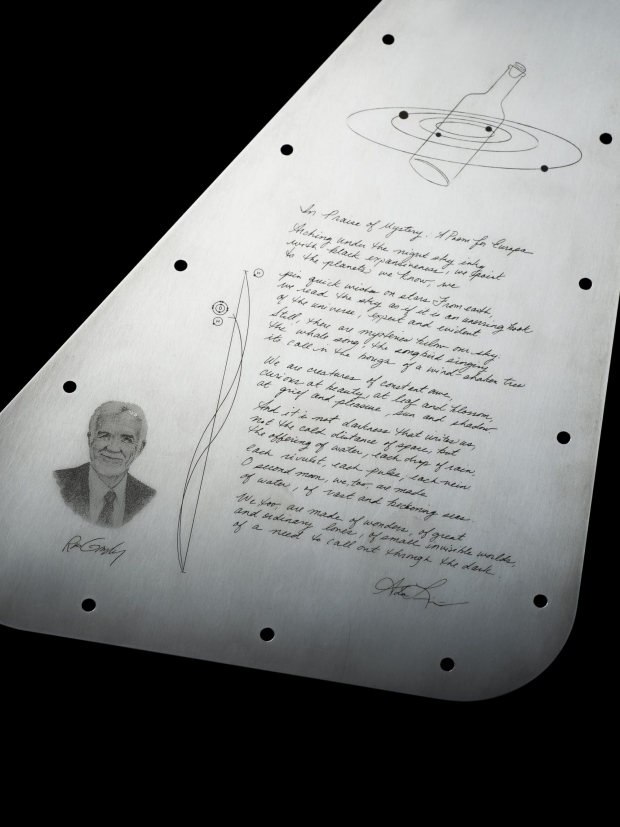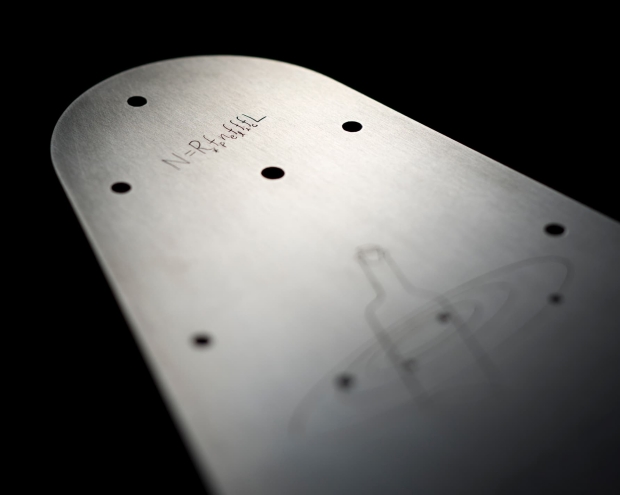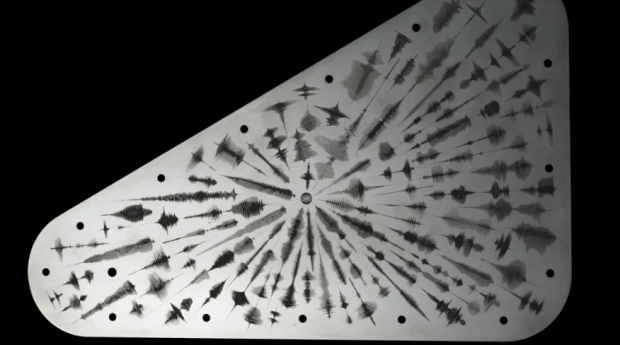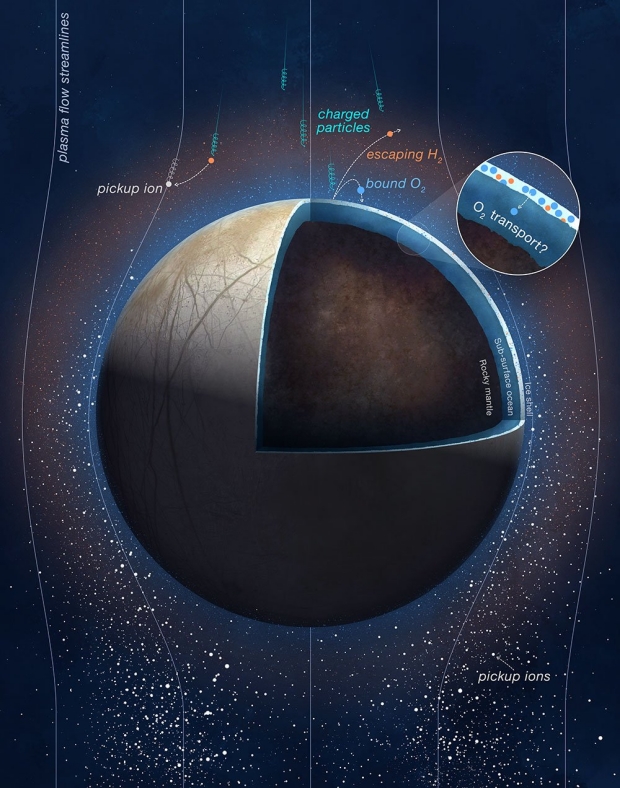We’re a species that likes to leave evidence of itself in new places. In Greenland, for example, the Kingittorsuaq runestone, dating from the 14th Century, offers inscriptions that help chart Norse exploration of the region. The oldest inscription at New Mexico’s El Morro dates from 1605, though many explorers left their names and stories on the cliffs there. Apollo 11’s plaque, with its “We came in peace for all mankind” is justly famous, as are the Golden Records of the two Voyagers and the Pioneer plaques, even if the latter were dogged with controversy at the time of their unveiling.

Image: The Kingittorsuaq runestone. Credit: Ukendt /Nationalmuseet, Danmark, CC BY-SA 2.5 DK
Clearly the Solar System is wide open for future plaques and markers, so that NASA’s inclusion of a plaque aboard Europa Clipper comes as no surprise. The poem it carries focuses, of course, on that intriguing moon, and I rather like poet Ada Limón’s “In Praise of Mystery: A Poem for Europa” except for its first stanza. I snag on the word ‘expansiveness,’ and the notion of a sky inky with it. The word ‘expanse’ is itself so liminal, especially as applied to an inky night sky, that it carries its own freight of awe.
To this jaded ear, ‘expansiveness’ is bloated. I can’t imagine saying ‘the sky is certainly inky with expansiveness tonight.’ So I’ll pass on stanza 1, but go for the rest of the poem, which is a deft evocation of water’s place in our evolution and our explorations:
Arching under the night sky inky
with black expansiveness, we point
to the planets we know, we
pin quick wishes on stars. From earth,
we read the sky as if it is an unerring book
of the universe, expert and evident.
Still, there are mysteries below our sky:
the whale song, the songbird singing
its call in the bough of a wind-shaken tree.
We are creatures of constant awe,
curious at beauty, at leaf and blossom,
at grief and pleasure, sun and shadow.
And it is not darkness that unites us,
not the cold distance of space, but
the offering of water, each drop of rain,
each rivulet, each pulse, each vein.
O second moon, we, too, are made
of water, of vast and beckoning seas.
We, too, are made of wonders, of great
and ordinary loves, of small invisible worlds,
of a need to call out through the dark.
Those last three stanzas form a fine conclusion; the poem ends with a satisfying click describing its mission, which is to fly aboard Europa Clipper and wind up hurtling past the target world again and again, battered by radiation as it hunts for information about an alien sea. What a good thing it is to put human artifacts on spacecraft. There is scant likelihood, of course, that the Europa poem, flying along with a microchip containing 2.6 million names submitted by the public, will one day be read by anyone, but the impulse is to commemorate and inspire ourselves. It’s something we humans do.

Image: The lower half of Europa Clipper’s vault plate, showing the poem by U.S. poet laureate Ada Limón (lower right), a drawing representing the Jovian system that will host the names of 2.6 million people flying with the mission on a microchip (top right), a tribute to planetary scientist Ron Greely (bottom left), and the radio emission lines known as the ‘Water Hole’ (center). Credit: NASA/JPL-Caltech.
As a collector and user of vintage fountain pens, I am particularly pleased to see that the poem is inscribed in the author’s handwriting, a nice touch in an era increasingly learning that writing by hand, though rarely taught these days, is actually a powerful way to explore and retain ideas. The vault plate, which you can explore here, likewise contains Frank Drake’s handwriting. Drake (1930-2022), among much else in a magnificent career, contributed the first SETI search, at Green Bank in West Virginia, and the seminal Drake Equation, which estimates the probability of finding life elsewhere in the cosmos and describes the factors critical to the discussion.

Image: The upper half of Europa Clipper’s vault plate, showing the Drake Equation in Frank Drake’s own handwriting. Credit: NASA/JPL-Caltech
The Europa Clipper vault plate is small, measuring 1 millimeter in thickness and 18 X 28 centimeters. What I’ve described so far is the inner-facing plate. The outer side contains a visual representation of the word for ‘water’ spoken in 103 languages, with the central symbol the sign for water in American Sign Language. Water, after all, is why we are probing Europa. Audio renditions of these words are contained as visual waveforms representing each sound. They look a bit runic to me.

Image: The art on this side of the plate, which will seal an opening of the vault on NASA’s Europa Clipper, features waveforms that are visual representations of the sound waves formed by the word “water” in 103 languages. At center is a symbol representing the American Sign Language sign for “water.” Credit: NASA/JPL-Caltech.
We’re going to get 49 close passes of Europa if all goes well when the spacecraft arrives in 2030. The commemorative plate seals an opening in the metal vault which will protect the craft’s sensitive electronics from the sleet of particles produced by interactions between the planet and its magnetic fields. We can hope to learn a good deal more about the thickness of the moon’s icy crust, its interactions with the ocean below, the composition of that ocean, and the geology of the surface. We’re getting close to Europa Clipper’s launch, slated for October at Kennedy Space Center.
Jupiter’s radiation belts, we’ve recently learned, may play a role in what goes on in the ocean below. As a paper in Nature Astronomy explains, the bombardment of ionized particles can split any water molecules encountered on the surface, producing oxygen that could find its way into the ocean. Thus lead author Jamey Szalay (Princeton University):
“Europa is like an ice ball slowly losing its water in a flowing stream. Except, in this case, the stream is a fluid of ionized particles swept around Jupiter by its extraordinary magnetic field. When these ionized particles impact Europa, they break up the water-ice molecule by molecule on the surface to produce hydrogen and oxygen. In a way, the entire ice shell is being continuously eroded by waves of charged particles washing up upon it.”
The Juno spacecraft’s Jovian Auroral Distributions Experiment (JADE) instrument flew within 354 kilometers of the surface in September of 2022, measuring the hydrogen and oxygen ions created by the particle bombardment. The work allowed a calculation of the rate of oxygen being produced at Europa, which turns out to be about 12 kilograms per second (previous estimates have reached as high as 1000 kilograms per second). “[W]hat we didn’t realize,” adds Szalay, “is that Juno’s observations would give us such a tight constraint on the amount of oxygen produced in Europa’s icy surface.” How much of this oxygen, if any, works its way into the ocean to provide potential metabolic energy is something Europa Clipper should help us understand.

Image: This illustration shows charged particles from Jupiter impacting Europa’s surface, splitting frozen water molecules into oxygen and hydrogen molecules. Scientists believe some of these newly created oxygen gases could migrate toward the moon’s subsurface ocean, as depicted in the inset image. Credit: NASA/JPL-Caltech/SWRI/PU.
The paper is Szalay et al., “Oxygen production from dissociation of Europa’s water-ice surface,” Nature Astronomy 04 March 2024 (full text).



There’s something feyly nihilistic about the art of outreach. We’re distracted with a Pioneer plaque on a craft that I assume will be de-orbited into Jupiter for planetary protection; but this one leads not to Earth, but to American sign language. Had it reached them, I imagine our alien friends wracking their thought-organs, poring over recordings of gravitational waves and pulsar events, struggling to identify the ones that say “water”. We provide potential inhabitants of Europa with an equation (well, at least multiplied variables) that doesn’t consider the possibility of life on moons, supplemented with wishes on stars and Mercury in a bottle.
The true poetry is not written by Vogons, but by the scientists whose instruments are the reason for the journey. Because it is too radioactive for the probe to land on Europa, Europa will land on the probe: dust from the surface and vapor from the ocean tested with mass spectrometry. Though it cannot dig to the hidden ocean, the probe will measure Doppler shift caused by the moon’s gravity and flux affected by its magnetic field to see what is there. A bleak moon will reveal its beauty in every color of an expanded rainbow: radar, IR, NIR, visible, UV. The probe might not find life; but it might find a source of usable water to bring life to places it has never been.
I agree with your sentiment about the poetry being in the science. Dawkins expressed this well in his book “Unweaving the Rainbow: Science, Delusion and the Appetite for Wonder”.
While the outer system has water in abundance, I still see Ceres as the most accessible water in the system. Once it is consumed, then we can mine the icy moons all the way out until we have consumed the Oort cloud. If only Asimov had known that Europa alone has more water than Earth’s oceans, his Martians would not have had to mine water from Saturn’s rings for their rockets, after Earth denied their use of ocean water.
The Martians may not have to go that far! Here’s today’s tale of a giant volcano near the equator of Mars, with buried glaciers and “blistered” terrain riddled with caves. The only thing Arthur Conan Doyle could add would be relict dinosaurs thoughtfully left behind by some primeval curator. Fingers crossed? https://phys.org/news/2024-03-giant-volcano-mars.html https://www.hou.usra.edu/meetings/lpsc2024/pdf/2745.pdf
I am not clear why there is interest in the Europan production of O2 that could seep into the subsurface ocean. The annual production of O2 would be less than 1E6 MT, compared to the many gigatonnes of O2 produced and consumed on Earth.
Even if all the O2 produced over 1 billion years ended up in the Europan ocean, it would be 1/1000th the mass of the water. This wouldn’t support aerobic life and at best would be analogous to the pre-GOE on Earth where the oceans were mostly anoxic with the very low O2 levels produced by cyanobacteria being quickly used to oxidize iron.
The O2 in the icy crust would be bound to become H2O2, which in turn would become very dilute peroxide at the ocean-crust interface before the was transferred to more reactive elements. Would a core drilled into the ocean sediments show a history of O2 production patterns?
Let’s suppose life does exist at ocean vents. It would probably be anerobic. whether methanogens like the archaea, or chemotrophs like the bacteria. If carbon fixation occurred, perhaps using IR light from the vents, then I would expect the O2 production (but more likely sulfur) to far exceed that produced at the surface.
So I really don’t understand the emphasis of surface O2 production reaching the subsurface oceans: at least as far as life is concerned.
[Caveat. Would aerobic life migrate to the ocean-crust interface to sip on the O2 before it was taken up by reactive elements? Would such life migrate into the crust to use the O2, still bound as peroxide, to support their aerobic metabolisms? A deep, COLD biosphere?]
Good point. The first life on Earth was anerobic. I will argue although the first life did not need light because there was no photosynthesis, it still needed light to get the right chemistry. https://astrobiology.nasa.gov/news/suns-uv-light-helped-spark-life/ This could be looked at symbolically, psychologically or religiously if we include the feeling function.
Any finding of life, more so if differing in nucleotide sequence code, chirality et cetera, would suggest ubiquity of abiogenesis; but with the absence of any detected advanced life-forms anywhere (besides earth), it could also be a possible harbinger of a Great Filter ahead
Just wondering if an Alien race came across the message with the bottle inscription on it they may think we are alcoholics..hic.
Perhaps one day if we colonise europa we could create magnetic fields that funnels the charge ions into the poles to increase the amount of oxygen and hydrogen generated. Jupiters magnetic field is enormous and well into the terrawatts and would be very useful to us.
Here is my take on sending messages beyond Earth…
https://www.centauri-dreams.org/2013/01/18/the-last-pictures-contemporary-pessimism-and-hope-for-the-future/
This essay discusses the Voyager Interstellar Record and the various reactions to it…
https://www.centauri-dreams.org/2018/10/12/the-farthest-voyager-in-space/
This essay includes discussion of the Pioneer Plaque and how our first vessels to leave the Sol system are also our first “ambassadors” into the wider Milky Way galaxy…
https://www.centauri-dreams.org/2012/04/30/our-first-galactic-ambassador/
I just love this beautiful program on the Pioneer Plaque from The Beauty of Diagrams…
https://www.youtube.com/watch?v=G4bqHCgwZac
Will solar sails play a role in finding life on Europa, Enceladus, and elsewhere…
https://www.space.com/solar-sails-hunt-alien-life-europa-enceladus
To quote:
Some scientists think solar sails could even propel humanity’s first interstellar missions. For instance, the $100 million Breakthrough Starshot Initiative, announced in 2016, aims to build a swarm of lightweight microchip-sized spacecraft and send them to Alpha Centauri, the nearest star system to Earth. Propelled by lasers at 20% the speed of light, these light sails could reach Alpha Centauri in just 20 years—within our lifetimes.
After 65 years of exploring our solar system with conventional rocket technology, “at some point, we’re going to encounter the limits of what can be explored with chemical propulsion,” said Lingam. Solar sail technology could very well herald a new era of space exploration, he added, especially if it’s going to be well-suited to search for signs of life in places “considered among the most promising habitats for life.”
Our solar system’s ocean moons may be habitable — and their icy shells could hold proof
By Tereza Pultarova
published March 05, 2024
Scientists think a process observed in Antarctic ice shelves must be at play on Europa and Enceladus.
https://www.space.com/solar-system-ocean-moon-habitable-ice-shell
A fresh example of the cultural impact placing messages and other information packages on deep space vessels has on humanity, despite what certain people who made those missions at the time felt about them. They have become the truly legacies and one day they may have an even bigger impact on other societies…
https://screenrant.com/the-signal-2024-golden-record-voyager-true-story-explained/
Previous cultural impacts by the Voyagers…
https://voyager.jpl.nasa.gov/news/details.php?article_id=109